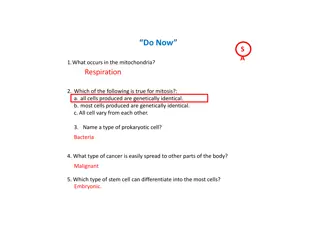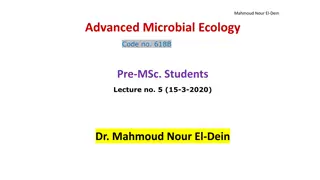Exploring the World of Microorganisms: History, Characteristics, and Importance
The field of Microbiology delves into the study of microorganisms, which are tiny organisms invisible to the naked eye. These microorganisms are ubiquitous in various environments, playing vital roles in processes such as food digestion, photosynthesis, and decomposition. They exhibit diverse characteristics and are classified into bacteria, fungi, algae, protozoa, and viruses. Understanding the history, scope, and significance of microorganisms is crucial for comprehending their impact on the ecosystem and human health.
Download Presentation

Please find below an Image/Link to download the presentation.
The content on the website is provided AS IS for your information and personal use only. It may not be sold, licensed, or shared on other websites without obtaining consent from the author.If you encounter any issues during the download, it is possible that the publisher has removed the file from their server.
You are allowed to download the files provided on this website for personal or commercial use, subject to the condition that they are used lawfully. All files are the property of their respective owners.
The content on the website is provided AS IS for your information and personal use only. It may not be sold, licensed, or shared on other websites without obtaining consent from the author.
E N D
Presentation Transcript
TOPIC: HISTORY AND SCOPE OF MICROBIOLOGY Introduction Microorganisms and the environment Characteristics of microorganisms. Importance of microorganisms. Nomenclature. Tools in microbiology. History/discovery of microbes.
INTRODUCTION The study of microorganisms is called Microbiology, a subject that began with Antony van Leeuwenhoek s discovery of microorganisms in 1675, using a microscope of his own design. Microbe is a short form of microorganism meaning small organism. This term was first used in 1878 by Sedillot Microorganisms are organisms that are too tiny to be seen with the naked eyes except with the help of a microscope. They are the oldest form of life on the surface the earth. Microbiology constitutes of branches:parasitology, bacteriology,virology,mycology,immunology e.t.c
MICRORGANISMS AND THE ENVIRONMENT Found almost everywhere. Found all over the skin even on our eyelashes. In the intestine where they help in food digestion The ones that has chloroplast like algae help in photosynthesis. Soil microbes helps to break down down plant and animal matter into smaller particles turning it to matter that other organisms can use as nutrient. Some invade the body causing sickness
GENERAL CHARACTERISTICS OF MICROORGANISMS They are the oldest and smallest form of life on the surface of the earth. Microbes can be found almost everywhere(in air, soil, food, water,and in the body e.t.c. Most microorganisms do not cause diseases and many are beneficial. They may be single-celled or multicellular. They may be composed of prokaryotic or eukaryotic cells. They play complex and unique roles within the ecosystem.
DIVERSITY OF MICROORGANISMS Microorganisms are very diverse; they are divided into five basic types which includes: 1. bacteria 2. Fungi, 3. Algae, 4. Protozoa 5. Viruses. Each type has a characteristic cellular composition, morphology, means of locomotion, and reproduction.
1.Bacteria They are Prokaryotes(no cell nucleus) Possess peptidoglycan cell walls Reproduce by binary fission Example: Escherichia coli 2.Fungi They are eukaryotes(cell nucleus) Have Chitin cell walls they are unicellular(molds and mushroom) and multicellular(yeast
3.Algae They are eukaryotes. Have cellulose cell walls. They are Photosynthetic. Produce molecular oxygen and organic compounds. They are part of food chain. 4.Protozoa Eukaryotes. Mostly saprobes and commensals May be motile by means of pseudopod, cilia or flagella
5.virus Simpler and smaller than prokaryotes Contains only a smaller amount of genetic material wrapped in a protein capsule. Cannot reproduce on its own;require host cell to inject their DNA or RNA into. Relies on the cellular machinery of the host cell to replicate the viral genetic material for it.
Characteristics of prokaryotes Represent earliest form of life on earth. Smaller and simple due to lack of several cellular material. And almost always single-celled Are broken into two categories: bacteria and archaea. Lacks nucleus to hold the cells DNA and lacks any sort of organized packaging or housing to hold the rest of the cell machinery.
characteristics of Eukaryotes Larger and more complex than prokaryotes Possess nucleus which neatly houses the DNA Self sufficient due to its several different organelles found in it e.g.golgi apparatus, endoplasmic reticulum, mitochondria, ribosomes as well as chloroplasts in photosynthesis cells. Examples of includes fungi, algae, protozoa and various microscopic parasitic worms.
Importance of Microorganisms Useful in studying molecular biology,biochemistry and genetics. Used in Vaccine development. Production of antibiotics. Production of important biological enzymes (insulin). Production of beer, wine, cheeses and yogurt. Maintenance of soil fertility/digestion in cattle and human. Help in degrading toxic waste materials.
Nomenclature Scientist Linnaeus introduced the binomial system of scientific nomenclature.it involves the genus and the species epithet. Each organism has two names: the genus and species epithet Italicized or underline Genus name is capitalized and species in lower case.
examples: Staphylococcus aureus describes clustered arrangement of cells and golden yellow color of colonies Escherichia coli Honors the discoverer, Theodor Escherich and describes its habitat, the colon. After the first use, scientific names may be abbreviated with the first letter of the genus and full species epithet. (Ex: E. coli)
Tools of Microbiology Compound light Microscope - Used to view live specimens. Electron Microscope - Used to view non-living specimens. Incubator used to keep microbes warm for growth Staining dye used to see structures better Microbial Culture the act of growing microbes. Petri dish-Container for microbe culture Culture media: Food for the microbes. e.g. Agar (from red algae).Others such as nutrient broths Autoclave-for sterilization of materials.
HISTORY/DISCOVERY OF MICROBIOLOGY The history of microbiology involved four major eras which includes: i. Discovery era. ii. Transition era. iii. Golden era. iv. Modern era
DISCOVERY ERA Discovery era: Aristotle (384-322) and others believed that living organisms could develop from non-living materials(e.g maggots arising from decaying meat). This belief gave rise to a debate which was referred to as Spontaneous Generation Theory : Spontaneous Generation Theory states that living organisms develop from non living matter. Antony van Leeuwenhoek s discovered microorganisms in 1675, using a microscope of his own design. He is the father of Bacteriology and protozoology. In 1676, he discovered, observed and described microorganisms such as bacteria and protozoa as Animalcules .
TRANSITION ERA In transition era, Francesco Redi between (1626 - 1697) showed that maggots would not arise from decaying meat, when it is covered. John Needham (1713 1781) spontaneous generation theory.. Lazzaro spallanzai (1729 1799). He demonstrated that air carried germs to the culture medium. He showed that boiled broth would not give rise to microscopic forms of life. Supported the
GOLDEN ERA GOLDEN ERA: In this era, Louis Pasteur Showed microbes caused fermentation. He studied spoilage and introduced Pasteurization to prevent it. Louis Pasteur is the father of Medical Microbiology. Pasteur in 1897 suggested that mild heating at 62.8 C (145 F) for 30 minutes rather than boiling was enough to destroy the undesirable organisms without ruining the taste of the product, the process was called Pasteurization
He fermentation and the development of effective vaccines ( rabies and anthrax). Pasteur demonstrated diseases of silkworm was due to a protozoan parasite. CONTRIBUTIONS OF LOIUS PASTEUR: He coined the term microbiology , aerobic, anaerobic. He disproved the theory of spontaneous generation. He demonstrated that anthrax was caused by bacteria and also produced the vaccine for the disease. He developed live attenuated vaccine for the disease. invented the processes of pasteurization,
He was the first to use agar as solid culture medium in bacteriology.. In 1876 - Robert Koch provided proof that a bacterium causes anthrax using experimental steps now called the Koch s Postulates
KOCH'S POSTULATES: The microbe must always be present in every case of the disease It must be isolated in pure culture on artificial media When inoculated into healthy animal host it should produce the same disease It must be isolated from the diseased animal again.
Fanne Eilshemius Hesse (1850 - 1934).He is one of Koch's assistant first proposed the use of agar in culture media. It was not attacked by most bacteria. Agar is better than gelatin because of its higher melting pointing (96 c) and solidifying (40 45 c)points. Richard Petri (1887). He developed the Petri dish (plate), a container used for solid culture media
Edward Jenner (1749-1823).First to prevent small pox.He discovered the technique of vaccination. Alexander Flemming(1945).He discovered the penicillin from penicillium notatum that destroy several pathogenic bacteria. Paul Erlich (1920).He discovered the treatment of syphilis by using arsenic.He Studied toxins and antitoxins in quantitative terms & laid foundation of biological standardization
MODERN ERA MODERN ERA: It s the Nobel Laureates Years. In 1901 Von behring: discovered Diptheria antitoxin 1902 Ronald Ross: ,, Malaria 1905 Robert koch : ,, Tuberculosis 1908 Metchnikoff: ,, Phagocytosis 1945 Flemming : ,, Penicillin 1962 Watson,Crick : ,, DNA structure 1968 Holley,Khorana : ,, Genetic code 1997 Pruisne: ,, Prions 2002 Brenner, Hervitz : ,, Genetic regulation of organ development &cell death
Modern Microbiology Modern microbiology reaches into many fields of human endeavor, including the development of pharmaceutical products, the use of quality control methods in food and dairy product production, the control of disease causing microorganisms in consumable waters, and the industrial applications of microorganisms. Microorganisms are used to produce vitamins, amino acids, enzymes, and growth supplements. They manufacture many foods, including fermented dairy products (sour cream, yogurt, and buttermilk), as well as other fermented foods such as pickles, sauerkraut, breads, and alcoholic beverages. In biotechnology, microorganisms are used as living factories to produce pharmaceuticals that otherwise could not be manufactured. These substances include the human hormone insulin, the antiviral substance interferon, numerous blood clotting factors and clot dissolving enzymes, and a number of vaccines.
OTHER IMPORTANT DISCOVERIES Bacteria: Hansen (1874) discovered Leprosy bacllus Neisser (1879) Ogston (1881) Loeffler (1884) Roux and Yersin Viruses: Beijerinck (1898) - Coined the term Virus for filterable infectious agents. Pasteur developed Rabies vaccine. Charles Chamberland, one of Pasteur s associates constructed a porcelain bacterial filter. Twort and d Herelle discovered Bacteriophages. Edward Jenner discovered Vaccination for Smallpox. ,, ,, Gonococcus Staphylococcus Diphtheria bacillus Diphtheria toxin ,, ,,
GRAM STAINING Reagents: Crystal Violet, Iodine, Ethyl alcohol (95%), Safranin Principle: The Grams staining (developed by Dr. Hans Christian Gram) is used to differentiate the bacterial cell into two major groups Gram positive and Gram negative which makes it an essential tool for classification and differentiation of microorganisms. Crystal violet is used as a primary stain and iodine acts as a mordant which increases the affinity of the cells for the stain. Ethyl alcohol 95% is used as de-colorizing agent, which acts as lipid solvent and also as protein dehydrating agent, Safranin is used as the secondary stain. Procedure 1. Thin smears of the isolated different colonies were prepared, air dried, and heat fixed. 2. Smear was covered with crystal violet for 60 seconds. 3. The stain was washed off using distilled water. The excess water was drained off. 4. The smear was covered with Gram s iodine solution and kept for 60 seconds. 5. The Gram s iodine was poured off and the smear was flooded with 95% alcohol for 30 seconds. The slide was washed with distilled water.
6. The counter stain Safranin was added to smear and was kept for 60 seconds. The stain was washed gently for few seconds. 7. The slide was air dried and, examined with a light microscope under oil immersion.























